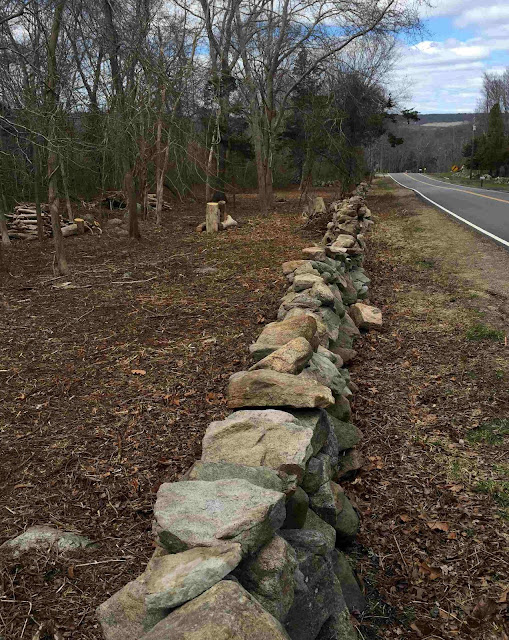By Beth Sullivan
This is the fifth year that the
Goodwin Niering Center for the Environment at Connecticut College has
collaborated with Avalonia to provide students with first hand
knowledge of how a land trust functions and to give Avalonia some
much needed energy, assistance and strength.
In past years, one student has taken
over writing the blog for me, as part of an outreach project and to
introduce the students. This year no one decided to take me up on
that, so I will be writing a few of these entries to describe what
some of the teams have chosen as their projects.
 |
| The frontage was overwhelmed by brush and litter. |
Ricardo Olea and Emilio Pallares
recognized that our outreach efforts, publications and web photos
were lacking in diversity. We discussed several ways to remedy this,
and their goal will be to engage diverse students from New London
schools near the College, get them outside at the Arboretum, and get
some great photos for us to use to be more inclusive. They will
promote the new Hike and Seek program and encourage city kids to
venture out onto Avalonia trails not far from town for education,
fun and, adventure. As they work toward this goal, Ricardo told me
about his unique campus group: MEChA ( explanation coming shortly)
which needed some community service time and offered to spend a
Saturday morning with me, working at a preserve of my choosing.
 |
| Invasives were impenetrable behind the wall. |
Collier Preserve Clean-up
Great. I never turn down strong
young helpers, and it would give me a chance to talk a bit more with
Ricardo about his project. We chose the Marjorie Stanton Middleton
Collier Preserve, near the top of Quoketaug Hill on Pequot Trail.
Over the winter a dedicated volunteer has hacked away at vines
strangling the trees and covering the walls. (Thanks Jim.) There
was so much dead wood, and dense invasive growth and brush, that the
roadside walls were barely visible, and the frontage was a mess. The
preserve was donated to Avalonia by the Collier family, one of the
founding families living up on the hill far back in Stonington
history.
 |
| A break of cookies and juice, and a therapy dog, was welcomed. |
 |
| Ann Collier, art of the donor family, last visited about four years ago. |
On a blustery Saturday, six
students, including Ricardo, showed up to help fix up the walls.
While none of us were stone workers by any stretch, with muscle and
some good tools and team work, they were able to get fallen rocks
lifted back onto the walls. Over decades these rocks had tumbled,
then become grown over and buried. Now they are back out where they
belong. The brush along the road and in a nice broad swath behind the
walls has been cut down. It is more open and appealing. Litter was
picked up by the bag-full, and the area is already drawing positive
comments from the neighbors.
 |
| Big, fallen rocks were placed back on the walls. |
 |
| The right tool and a great team made all the difference. |
But now about MEChA. As I talked
with Ricardo and his friends, they explained that their group was
comprised of students of similar ethnic backgrounds going back to
indigenous people in Mexico, before Spanish influence. I was
intrigued. I will quote Ricardo here as he described his group:
“Movimiento
Estudiantil Chicanx de Aztlán (MEChA) is a student organization that
promotes higher education, culture, and history. Each word in MEChA
symbolizes a great concept in terms of la
causa (the
cause). Movimiento means that the organization is dedicated to the
movement to gain self-determination for our people. Estudiantil,
identifies the organization as a student group for we are part of our
Raza's future. At the heart of the name is the use of the identity:
Chicanx. At first seen as a negative word, now taken for a badge of
honor. In adopting their new identity, students committed themselves
to return to the barrios, colonias, or campos and together, struggle
against the forces that oppress our people. Lastly, the affirmation
that we are Indigenous people to this land by placing our movement
in Aztlán, the homeland of all peoples from Anahuak.
The
term Anahuak is more of a general term often
used interchangeably with Valley
of Mexico
, and both Aztec and Mayan civilizations fall under the umberalla of
Anahuak.
It is the core of ancient Mexico. This is generally where Mexico City
is located today. Essentially, it is where the indigenous peoples of
Mexico are said to have originated from.”
 |
| What a change! |
I
found it refreshing to meet and learn about a group of young people
who take pride in their heritage. They set great examples for
others too as they support the greater community and promote
diversity and understanding. Thanks for all the muscle too.
Photographs
by Beth Sullivan

No comments:
Post a Comment